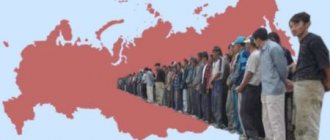The dynamic development of modern society leads to constant changes, and in order to exist in it, one has to master new knowledge and gain experience. And the right approach to business requires not only the presence of this powerful tool, but also its competent use. Thus, the opportunity is given to get maximum benefit from all this and satisfy human needs in society.
It is no secret that for the same job at different enterprises in different states, wages may differ. It is worth considering that people have the opportunity to migrate abroad and find decent work with appropriate pay.
What is international labor migration
International labor migration is the movement of labor resources not within a state, but from one country to another with the possibility of obtaining permanent or temporary residence and work. It goes without saying that labor migration is a complex process and is due to a number of reasons that can be classified as follows:
- economic;
- ideological;
- political;
- depending on religion;
- personal;
- national.
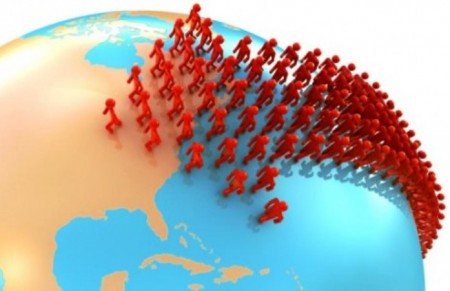
Economic reasons include:
- The unequal level of development of states, from an economic point of view, which leads to a significant difference in wages. Thus, it becomes clear why the movement of labor occurs from countries with a low standard of living to more developed countries, where the GDP indicator is higher;
- Unemployment is one of the main economic factors that significantly affects the migration processes of the population. It is for this reason that people start looking for work outside the state;
- Transnational corporations. Their presence leads to the migration of part of the workforce to jobs located in foreign transcorporate branches.
All other categories of factors are classified as non-economic reasons: each of them can provoke mass migration processes. As for the consequences, for the economic sector they will be similar to those that arose due to economic reasons.
The difference between two streams of international labor migration should be taken into account: emigration and immigration.
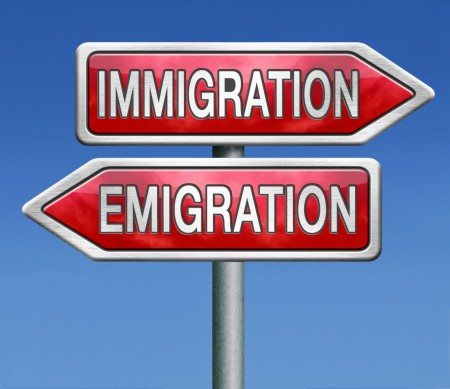
Emigration is the departure of people of working age abroad, while immigration is the reverse process.
The scope of international labor migration is assessed through the following indicators:
- The volume of departures is the number of emigrants who migrated abroad with the goal of getting a job;
- Volumes of arrivals – the number of migrants who came to the country in order to find work;
- The migration balance is an indicator representing the difference between the number of visits to a given state and the number of departures from it over a certain period of time. The migration balance can be both negative and positive;
- Gross migration is the total expression of the number of arrivals and departures from a country over a period of time.
Main directions of international labor migration
Among the directions of international labor migration the following can be distinguished:
- Moving from a developing state to an economically developed country. In this matter, the industrialization of the country, which provides a higher standard of living, is of great importance. This was the main reason for the development of migration processes. We should not exclude the fact that in countries with developed economies there are also non-prestigious specialties, but it is impossible to do without them. As practice shows, foreign labor takes precisely such places. For example, in France, the percentage of emigrants is 25% of the total number of professional construction workers and approximately 32% of workers in the automotive industry. In Belgium, foreigners make up 1/2 of the total number of miners, and in Switzerland about 40% of the number of construction workers. This direction of migration policy has led to an outflow of highly qualified personnel from developing countries. Experts have noted the dual impact of this factor on the state and development of the economies of both countries. Although, for the most part, the following trend is observed: a negative impact on developing countries and economic growth in industrialized countries, allowing significant savings in public money, which are allocated for the training of highly qualified specialists.
- Moving from one developed country to another developed country. Labor migration at this level is explained by the presence of non-economic factors. The reasons in this case may be the search for a highly paid and prestigious job. Separately, it should be noted the international direction of labor resources between the countries of the European Union. In 1993, the European Union became a single market space, which made it possible to move freely from one state to another in order to obtain decent work.
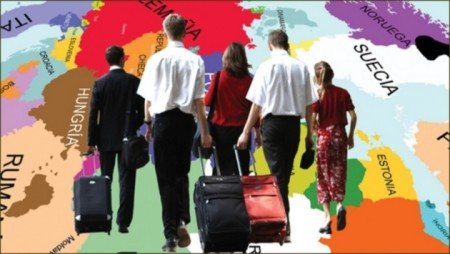
- From economically developed countries to countries with lower economies. This trend can be explained by the presence of job offers from specific firms or the government.
- Migration from one developing country to another. The purpose of international migration of this kind is to improve living standards. In most cases, labor migration exists between Asian countries and oil exporting countries.
The concept and essence of labor migration
At the present stage of economic development of the world, there are trends of globalization and integration of the economic systems of individual countries.
Against this background, interaction occurs between states not only regarding finished goods and services, but also regarding factors of production. Human capital, which is represented by a workforce of various levels of qualifications and professional training, is now playing an increasingly important role in economic growth and development. Definition 1
International labor migration is a complex process of moving able-bodied citizens between states with a period of residence in a new place of more than twelve months.
Finished works on a similar topic
- Course work Migration of labor, its causes and types 410 rub.
- Abstract Labor migration, its causes and types 230 rub.
- Test work Migration of labor, its causes and types 250 rub.
Receive completed work or specialist advice on your educational project Find out the cost
The entire set of migration processes is represented in two directions:
- Emigration is leaving one's own state.
- Immigration is entry into the territory of a foreign country.
- Re-emigration is the return of previously emigrated citizens to their homeland.
We can say that migration is the import and export of human resources. The income of the “donor country” is formed from cash contributions and transfers of citizens to their relatives back home. Migration allows us to solve the issue of unemployment with a high volume of supply in the domestic market. This has a positive effect on the unemployment rate, as well as on increasing state budget revenues.
However, the outflow of highly qualified specialists affects the slowdown in economic growth, as well as the development of its priority areas.
Migration can be internal or external. The first occurs within the state, between its regions. With its help, the redistribution of human resources is carried out. External migration affects the number of citizens and affects the ratio of the number of migrants and emigrants. Currently, migration is associated with the uneven economic development of states. In developed countries, the manufacturing sector is constantly in need of additional labor, while in developing countries there is often a shortage of jobs. The territorial distribution of labor also affects migration. Most of the working-age population lives in Asia and Africa.
Do you need proofreading or review of academic work? Ask a question to the teacher and get an answer in 15 minutes! Ask a Question
Types of migrants
First of all, one should see the difference between labor migration and the small number of businessmen and individual workers crossing the border for their own purposes. Among other things, individual employees of modern companies are often forced to leave the country to train new employees, conduct lectures, seminars and monitor the quality and performance of work. This trend is inherent in corporate associations and their branches located in different parts of the world.

At this stage, there are several types of migrants, each of which should be considered separately.
- Migrants include foreigners seeking to leave for another state in order to obtain citizenship and obtain permanent residence. Such moves can be carried out either by families or by one person at a time. Countries that are popular for immigrants are America, Canada and some Western European countries. As for Russia, the country has developed special programs at the state level that focus on the return of foreign citizens to their country.

- Contractors. Such workers may even be unskilled, although most often they are semi-skilled. In economic terminology, contract workers are migrants who are required to leave the country and return to their homeland after the end of the contract. They include seasonal workers, seafarers and service workers.
- Highly qualified specialists are foreign citizens moving to another state with the goal of obtaining a decent job with the possibility of career growth. Most often, such workers migrate to countries with more developed economies. From an economic point of view, this process is called “brain drain”. In some cases, it becomes a serious problem for the state.

- Illegal migrants. One of the problems for international labor migration is illegal immigrants. These include the category of people who move abroad, bypassing legal boundaries and working unofficially. In some cases, migrants come to another country legally, for example, on call, and then try to stay in the country.

- Refugees. These include people who suffered due to certain circumstances due to political instability in the state, as a result of military operations and political persecution. They move abroad most often in order to change their place of residence with the opportunity to get a job.
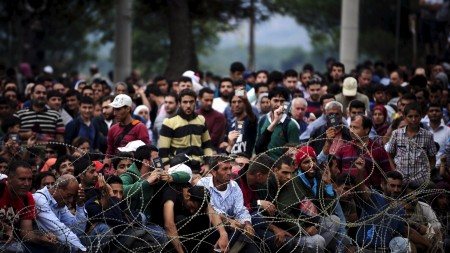
Types of labor migration
It is worth noting that international labor migration can have several varieties. Types of migration depend on the nature and reasons for the move. Government authorities usually carry out thoughtful regulation of migration processes in order to control the flow and turnover of foreigners in the country. The measures taken also affect the types of labor migration, simplifying or complicating the conditions for the relocation of foreigners. The main types of labor migration today include:
- Irreversible. This includes migrants who went abroad not only to earn money, but also for the purpose of permanent residence.
- Temporary. This group includes persons who live and work abroad for work purposes. The duration of the contract usually ranges from 1 to 5 years, after which the employee can extend the contract or return to his home country.
- Periodic. This type can be called one of the most common. International labor migration, in which individuals work for periods ranging from several months to a year and are employed in the service sector, agriculture and other industries associated with changing seasons.
- Pendulum. This species is available to residents of border regions and areas. People cross state borders every day to conduct business or work in neighboring territory.
- Illegal. Often, individuals enter the territory of another state for the purpose of tourism or visiting relatives, but remain in the country for a longer period than the entry document allows. In all countries of the world, government regulation is aimed at eradicating illegal labor migrants.
- "Brain drain" This term characterizes the international migration of labor resources, in which qualified personnel and valuable specialists, creative and scientific figures (directors, writers, actors, engineers, scientists, etc.) leave the country. In Russia, a massive migration of the best minds was noted in the period from 2000 to 2004.
International migration of labor resources in Russia at the current level
Recently, the number of contract migrants in the Russian Federation has decreased. The government of the country is trying to control the quantitative ratio of available places for employment and those wishing to get a job. International migration processes gained momentum in the country only after the collapse of the Union. Until this point, migration waves had taken place, but their main cause was either military conflict situations or political persecution.
Migrants have been able to leave Russia without any particular difficulties since 1992. This time period served as the beginning of labor migration for residents of Russia. A large number of high-class specialists, as well as ordinary workers, have the opportunity to find work abroad. It is worth noting that not all Russians set a goal to leave the country: some of them came back after a few years.
There was also such a problem in Russia as the outflow of highly qualified specialists and the simultaneous influx of illegal migrants. In this regard, the government took appropriate measures to regulate the flow of migrants of a certain category. This state of affairs was due to the fact that illegal immigrants turned out to be economically unprofitable for Russia, since they did not provide profit to the state, but only took a certain number of billions out of the country every year. It is worth noting that illegal migrants managed to get jobs in densely populated cities, providing serious competition to migrants who came to Russia legally.
Russian employers prefer foreign workers to natives and are much more willing to hire them. A significant advantage is that compatriots are fluent in Russian and are well acquainted with the history of the country, know local traditions and are economically beneficial for Russia. At the present stage, specialists have developed and put into effect a special repatriation program that makes it possible to employ compatriots. With its help, it is possible to regulate migration processes and facilitate the direction of compatriots to priority areas of the country. Typically these are regions where the labor force level is insufficient, as well as large settlements where there is a need to attract qualified specialists. The same can be stated regarding other Russian territories of a similar nature.
External labor migration in modern Russia
This article examines the dynamics of labor migration in Russia, factors motivating migration, as well as the role of labor migration in the Russian economy.
Key words: labor migration, migration factors, migration dynamics.
Currently, migration processes are receiving more and more attention. They influence, first of all, the demographic situation of the country and the structure of the state. The UN predicts that Russia's place in the world ranking of countries by population will be only 17 out of 285. In the future, labor migration may become the main source of increasing labor resources, including the population itself.
Among the economic reasons for labor migration, the following can be identified: differences in wage levels, the desire to improve one’s standard of living and income, and, of course, the main thing is the search for work.
For example, the Russian scientist V.I. Perevedentsev noted a wider range of problems, namely: territorial differences in living conditions and factors such as personality structure. [1]. That is, according to the scientist, the fundamental factor for making a decision on relocation is the difference between the level of personal development and the possible conditions for satisfying needs.
Russia is faced with problems such as out-of-control migration and population decline. At first, population growth was observed precisely due to migration processes. But natural growth was recorded only in 213. According to the decree of the President of the Russian Federation, by 2025 the estimated population will decrease and amount to approximately 124.8 million people. [2]
To stabilize the population, the task was set to attract migrants, taking into account their social adaptation. It is important to give emigrants the opportunity to return to permanent residence in the Russian Federation and also to provide assistance in the resettlement of compatriots. In addition, it is necessary to note the composition of migrants. For example, to improve the quality of migrants, it is necessary to attract foreign specialists with qualifications, including those who are graduates of Russian universities and other institutions.
Despite the situation with the falling exchange rate of the ruble, and, as a consequence, wages, everyone still goes to Russia to look for better living conditions. And even such a factor as tightening immigration laws does not weaken the flow of migrants. For example, according to the International Organization for Migration, the Russian Federation ranks third in the world in terms of the number of citizens accepted from other countries. [3] In the Russian Federation, residents of the former Soviet republics are especially prominent; mainly labor migrants come from Ukraine, Kazakhstan, Uzbekistan, Tajikistan, Belarus, and Azerbaijan.
Today, Russia is the most promising labor market for CIS migrants. This is due to the fact that the economic situation of these countries does not allow people to realize themselves as workers, and thereby improve their standard of living.
In modern society, international migration is fickle, so it is necessary to consider the possibility of improving migration legislation and regulating the relationship between migrants and the indigenous population. [4] To do this you need:
- Increase the flow of remittances from the country;
- Reduce interethnic tensions;
- Streamline the regime of entry into the territory of the Russian Federation;
- Adjust the migrant registration mechanism;
- Determine the level of responsibility for improper use of labor;
- Introduce benefits for highly qualified workers.
Also, in order to enhance the positive results from the process of labor migration and the presence of migrants on the territory of the state, it is necessary to improve the exchange of information with the top officials of the countries from which the largest flows of migrants can be traced.
In June 2010, the Concept of State Migration Policy of the Russian Federation for the period until 2025 was approved. This document officially states that attracting foreign workers is a necessity for the further progressive development of the Russian economy. This puts an end to the debate about whether migrants are needed or not.
The concept as a whole is focused on solving the problem of attracting migrants to the country to replenish the natural losses of the population, labor force and develop innovative potential.
The following current guidelines have been identified: an emphasis on permanent migration as the most effective, on attracting specialists, educational migration, opening new channels of mobility, including vacation student migration, a differentiated approach to different flows of migrants. For the first time, a thesis was voiced in the conceptual document regarding the personal interests of citizens: hiring migrants for domestic work. This is a symptomatic shift.
Great importance is attached to promoting the adaptation and integration of migrants and the formation of constructive interaction between migrants and the host community. A system of measures has been outlined to facilitate this task. Their expediency is not questioned.
At the same time, it is difficult to expect that the integration process can be successful with such a large proportion of irregular migrants as is currently observed. Introducing the bulk of migrants into the legal field is an essential condition for their successful integration, reducing corruption in the field of migration and reducing migration risks.
The looming influx of migrants, who differ sharply from the Russian population in ethnocultural terms, threatens society with a serious split and destabilization. Migration has already become a real bone of contention, a bargaining chip for election campaigns, a watershed for ideological trends, and a stronghold for nationalists.
Migration is one of the determining factors in Russia’s development—both its economic growth and social stability. The task of migration policy is to keep up with the ongoing migrations, and sometimes to preempt them. So far, unfortunately, it’s not working.
Literature:
- Perevedentsev V.I. Methods for studying population migration // USSR Academy of Sciences, Institute of International Labor Movement. -M.: Nauka, 1975. -231 s
- Official site . The concept of demographic policy of the Russian Federation for the period until 2025 [Electronic resource]. Access mode: https://www.consultant.ru/document/
- Demographic indicators of the Federal State Statistics Service [Electronic resource]. Access mode: https://www.gks.ru/wps/wcm/connect/rosstat_main/rosstat/ru/statistics/population/demography/#
- Ryazantsev S.V., Aidrus I.A., Pismennaya E.V. Demographic potential as the basis for the development of the higher education system Textbook. -M.: RUDN, 2008. -258
Countries with the largest flow of migrants
At the moment, the countries that are most attractive for migrants from other countries are being determined:
- United States, Australia and Canada. America can be considered one of the most developed countries, from an economic point of view. More emigrants come to the country every year than to other countries. This applies to workers with both high and low qualifications. Most low-skilled workers come to America from Mexico and other nearby Latin American countries. As for highly qualified specialists, they immigrate to the States from this world. The countries of Western Europe, India and Russia are no exception. According to statistics, the legal number of immigrants to America annually is about 740,000, and the number of emigrants is 160,000.

- Western European countries, members of the European Union. Labor resources migrate to these states from the countries of Western Europe, which are less developed, countries of Eastern Europe, as well as Arab states located in the northern part of Africa, the Middle East and the countries of the former Union. The increase in migration flow from Africa, whose territories are former colonies of Western European states, is facilitated by linguistic and economic ties and common traditions. The annual immigration flow in the 90s was about 180,000 people. In addition, there was a labor market. This fact implied the unhindered movement of labor between the states of the European Union.
Video about the route migrants take to reach Western Europe
- Near East. The main direction of this state is oil refining, which is considered the leading factor contributing to the attraction of cheap labor. The largest influx of workers is from neighboring Arab states. In addition, Indians, Pakistanis, residents of Bangladesh, Korea and the Philippines are drawn to the east.
- Other developing countries. An increase in migration flows is also observed in the most developing countries. In the usual scenario, labor flows are directed to the territories of states that have economic reforms as the basis for their promotion. For example, workers from Latin American countries are sent to Mexico and Argentina, and from the African continent to Nigeria and South Africa. Because of the fighting in the Persian Gulf in 1991, about a million Egyptian citizens left Iraq, almost as many Yemenis left Arabia, and about half of the Palestinian residents left Kuwait. Their places were taken by Indian and Egyptian residents.
- New industrial countries.


